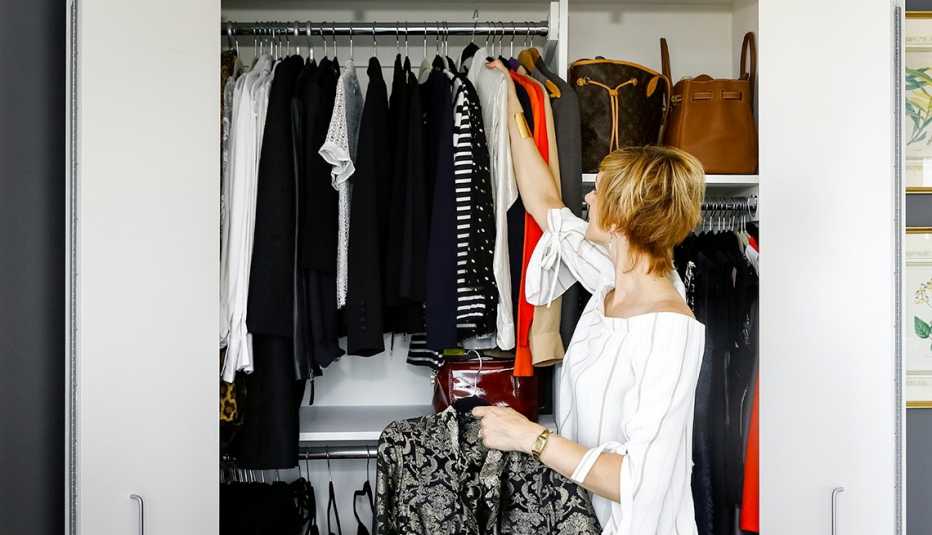AARP Hearing Center


“Should I toss, donate or keep this?” At 50, that’s a toughie. Our clothes have been our cheerleaders, confidence boosters and therapists. They got us through weight changes, difficult workdays, job interviews, dates, marriages and divorces. Breaking up is hard to do. Is that power-shoulder blazer from the ’80s a keeper? It’s a designer label! What about the green cowboy boots snagged on a road trip? They’d cost $700 today! How about all those perfectly faded jeans? Someday you may wear size 27 jeans and his may be a 34 waist… again. As I said, it’s not easy. Here are 10 ways to let it go:
1. Get your closet and psyche ready.
Treat yourself to a big batch of skinny flocked hangers in one neutral color. These will give you incentive, a sense of control and maximize the closet space. They also give your clothes a curated look and take up less space than a mishmash of wood, wire and plastic hangers. Empty your closet and clean it down to the last shelf, rod and dusty corner. Vacuum, dust and have big trash bags ready, labeled “toss” and “donate.” Possible keepers go on the bed till hang-up time. You’re now ready to pare down your clothes and clean up the clutter for the life and body you have today.


2. Toss anything past its expiration date.
Do this category first. Anything stained, worn out, threadbare, stretched, saggy or smelly is a goner. This includes dingy or damaged shirts and tees (check the underarms and neck!); old undies and nightwear (including bras, tights, shape wear and socks); frayed, ripped or ratty sneakers, grubby flip-flops and sandals (shoes expire quickly); grungy gym clothes and tired swimsuits; tees with quirky or inappropriate graphics and slogans (grandkids may want band or team tees); anything that shrank in the wash; stained, dilapidated bags and backpacks; and cracked and beaten-down wallets (clean out pockets for forgotten cards, cash and ID!). Most of the above do not meet donation standards (see tip 6 for an exception) but here are some suggestions for what to do with toss-ables other than put them in the trash: Give soft tops, tees and sweats to an animal shelter or turn them into household rags; search for local thrift shops that recycle textiles to reduce environmental waste; and check out H&M’s recycling program that takes drop-offs and sorts them for repurposing.


3. Donate whatever no longer works for you.
We’re not hoarders but we do tend to hold on to clothes and accessories. Giving away your stuff is emotional so try to ignore these common donation blockers: “What if I need this for a wedding/funeral/birthday someday?”; What if I lose 10 pounds this year?”; and “But it was so expensive!” First of all, your clothes preferences today are probably very different than they were 10 or even five years ago. Be guided by your current size and shape, where you live and your current style of dress. Think about what you’ve given up or would like to give up. Maybe you’ve said bye-bye to tuck-in tops, high heels or any dress that requires shapewear or dry cleaning. Maybe you now prefer tees and pullovers to buttoned shirts, lighter colors to black, V necklines and boatnecks to crews or pants to skirts. Keep the focus on your real life and tastes right now.


4. Surefire donations for him
Men resist closet purges just like we do. Anything that no longer fits your real-life scenario or hasn’t fit your body size-wise for two years is a giveaway. Maybe you’ve left corporate life for a part-time job or a WFH one, relocated to a different climate or just prefer more casual clothes. Old suits are good possible donations but if they fit (or nearly) keep two because weddings and formal events will come up. Give away baggy, saggy jeans that don’t fit your butt, waist or belly, stuffy pleated pants and chinos, shapeless oversize sweatshirts and sweaters, dress shirts that are too small or too wide, shirts that won’t work untucked if that’s his current style, ties that will never get worn (keep three for those suits though), leather belts and shoes that have seen better days, pilled sweaters and old eyeglasses.



































































More on Entertainment
10 Things in Your Wardrobe to Never Toss, Sell or Donate
Some classic shoes, clothes and accessories are declutter-proof11 Ways to Refresh Your Clothes and Closet
Prep your wardrobe for spring and summer with these DIY tips10 New Ways to Dress for Work Now
Fashion finds to wear to every mode of workplace
Recommended for You